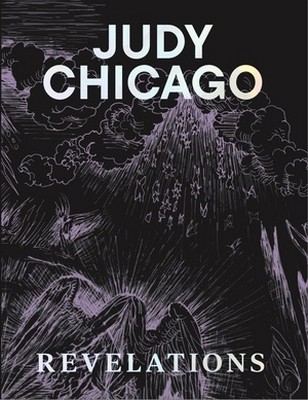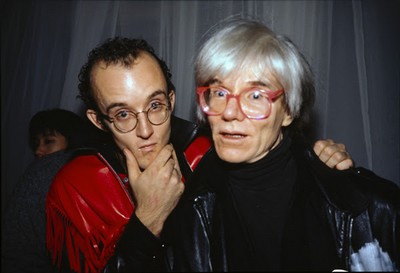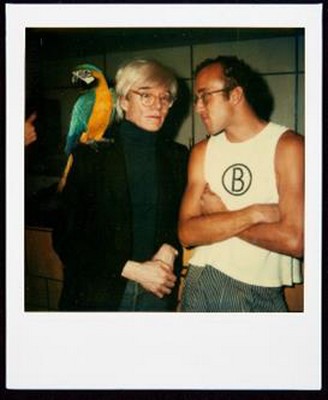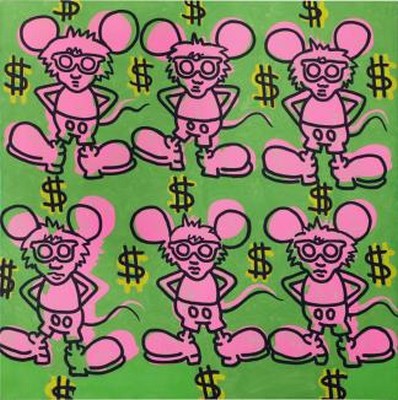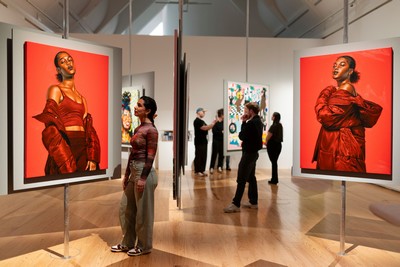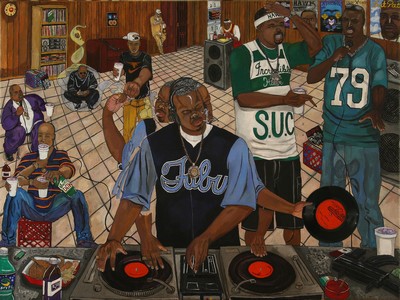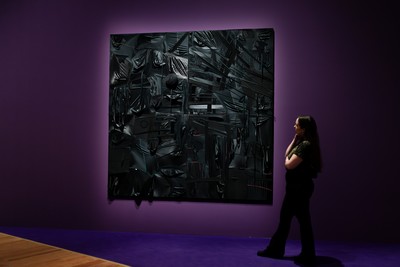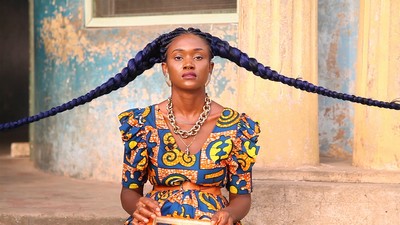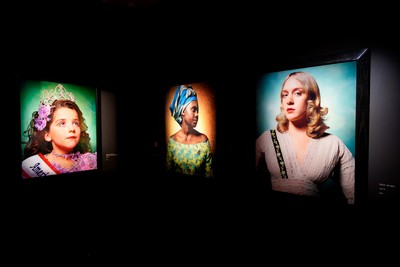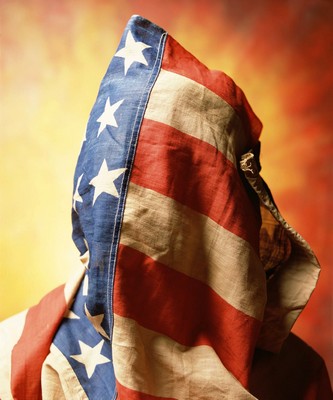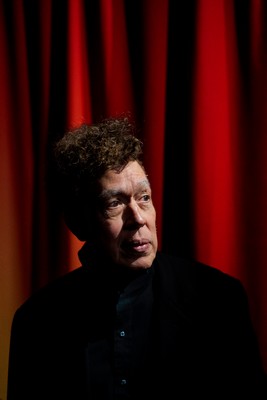THE CULTURE: HIP HOP AND CONTEMPORARY ART IN THE 21ST CENTURY
Schirn Kunsthalle Frankfurt
Through May 26, 2024
Open/Closed, 2021
Oil on canvas, 121.9 x 91.4 cm each,
Courtesy of the artist and Galerie Myrtis
© Monica Ikegwu
Open/Closed, 2021
Oil on canvas, 121.9 x 91.4 cm each,
Courtesy of the artist and Galerie Myrtis
© Monica Ikegwu
The Culture: Hip Hop and Contemporary Art in the 21st Century Exhibition view © Schirn Kunsthalle Frankfurt 2024
Photo: Emily Piwowar / NÓI Crew
Coinciding with the 50th anniversary of the birth of hip hop, the Schirn Kunsthalle Frankfurt dedicates a major interdisciplinary exhibition to hip hop’s profound influence on our current artistic and cultural landscape
Hip hop first emerged in the Bronx, New York, in the 1970s as a cultural movement among Black and Latinx youth. It quickly proliferated through large-scale block parties to encompass an entire culture that focuses around four pillars: MCing (or rapping); DJing; breaking (or breakdancing); and graffiti writing and visual art. From its inception, hip hop critiqued dominant structures and cultural narratives and offered new avenues for expressing diasporic experiences and creating alternative systems of power—which lead to a fifth pillar of social and political consciousness and knowledge-building. Hip hop has now evolved into a global phenomenon that has driven numerous innovations in music, fashion, and technology, as well as the visual and performing arts.
Grounded in the origins of hip hop in the US yet with a focus on art and music, the exhibition “THE CULTURE” features over 100 artworks mainly from the last twenty years, including paintings, photographs, sculptures, videos, and fashion, by internationally renowned contemporary artists such as Lauren Halsey, Julie Mehretu, Tschabalala Self, Arthur Jafa, Khalil Joseph, Virgil Abloh, and Gordon Parks. It is structured around six themes: Pose, Brand, Adornment, Tribute, Ascension, and Language. “THE CULTURE” illuminates hip hop’s unprecedented economic, social, and cultural resources that have made hip hop a global phenomenon and established it as the artistic canon of our time. The exhibition furthermore addresses contemporary issues and debates—from identity, racism, and appropriation to sexuality, feminism, and empowerment.
Sebastian Baden, director of the Schirn Kunsthalle Frankfurt, says: “Hip hop is a socially formative and influential cultural movement. The Schirn is presenting ‘THE CULTURE’ for the first time in Germany in an artistic exhibition context. In collaboration with our international partners, we show the immense influence that hip hop has had on contemporary art and pop culture in the past twenty years. With an extensive accompanying program, the Schirn additionally features the local hip hop scene—both its connections and its differences to US history, as well as contemporary debates around empowerment and identity.”
The cocurators of the exhibition Asma Naeem (Dorothy Wagner Wallis Director, Baltimore Museum of Art), Gamynne Guillotte (former Chief Education Officer, Baltimore Museum of Art), Hannah Klemm (former Associate Curator of Modern and Contemporary Art, Saint Louis Art Museum) and Andréa Purnell (Community Collaborations Manager, Saint Louis Art Museum) note: “Hip hop’s influence on culture is so significant that it has become the new canon—an alternate set of ideals of artistic beauty and excellence centered around Afro-Latinx identities and histories—and one that rivals the Western art historical canon around which many museums orient and develop exhibitions. The exhibition ‘THE CULTURE’ shows that many of the most compelling visual artists working today are directly engaging with central tenets of this canon in their practices. Across such vastly disparate fields as painting, performance, fashion, architecture, and computer programming, the visual culture of hip hop, along with its subversive tactics and its tackling of social justice, surface everywhere in the art of today.”
DJ Screw in Heaven, 2008
Acrylic on canvas, 96.5 x 121.9 cm
Private Collection, Houston
© El Franco Lee II
Seta's Room 1996, 2022
Photo transfer, paper, acrylic paint, thread
and painted canvas on canvas, 243.8 x 213.4 cm
Courtesy of the artist and Pilar Corris, London
© Tschabalala Self
It was all a dream, 2022
Acrylic on canvas, 170 x 175 cm
Courtesy of the artist, Simões de Assis and Luce Gallery
© Zéh Palito
EXHIBITION THEMES
In six themed sections, “THE CULTURE” presents artworks in dynamic dialogue with fashion and historical ephemera. Several of the works are directly related to hip-hop songs, which can be accessed and listened to in the exhibition via QR codes. Among the fashion highlights are looks from Virgil Abloh’s collections for Louis Vuitton, legendary streetwear brand Cross Colours, and Dapper Dan’s collaboration with Gucci. Highlights of the historic ephemera include a copy of the Jean-Michel Basquiat and Rammellzee album, Beat Bop / Test Pressing (1983), a Vivienne Westwood Buffalo hat (1984) made famous by Pharrell Williams at the 2014 Grammy awards, and several of Lil’ Kim’s iconic wigs recreated by the original hair stylist, Dionne Alexander.
The Culture: Hip Hop and Contemporary Art in the 21st Century Installation view Dionne Alexander, Lil’ Kim Wigs, 1999-2001
© Schirn Kunsthalle Frankfurt 2024,
Photo: Emily Piwowar / NÓI Crew
POSE
The works in this section explore what one’s gestures, stance, and mode of presentation can communicate to others. Artists like Michael Vasquez, Nina Chanel Abney, and Tschabalala Self explore and explode stereotypes of gender and race, examine the line between appreciation and appropriation, consider the relationship between audience and performer, and ask which bodies are considered dangerous or vulnerable—and who decides. For some, self-presentation is a means of survival, for others a way to claim space in a hostile world, and for still others a tool for changing dominant narratives about what can be communicated through the body.
BRAND
The concept of a brand is not limited to differentiating and marketing commercial goods but extends to how an individual uses available communication technologies—including social media—to position oneself in the public sphere. In previous decades, hip-hop artists have functioned as unofficial promoters of major brands that aligned with their style and desired public persona. The borrowing of luxury brands to create something unique questions the notion of the “original,” as in the fashion by the legendary designer Daniel R. Day, better known as Dapper Dan—in turn underlining the uneasy relationship between symbols of luxury and those that brands deliberately exclude. Whether designing fashion, recording music, or making art, artists blur the boundaries between these art forms, between being in business and being the business. The exhibition presents works by Kudzanai Chiurai, Larry W. Cook, and a video produced in a collaboration between Arthur Jafa, Malik Sayeed, and Elissa Blount Moorhead, which address consumerism, the ostentatious flaunting of luxury goods, and the complex and entrenched notions of masculinity that are common among many hip-hop stars.
Black Power, 2006
Chromogenic print, 40.6 x 50.8 cm
Barret Barrera Projects
© Hank Willis Thomas
ADORNMENT
While style often signifies class and politics, almost no culture dresses as self-referentially—or as influentially—as hip hop. From Lil’ Kim’s technicolor wigs to the exuberant, excessive layering of gold chains by Big Daddy Kane and Rakim, some of the most important and unique styles have originated in hip hop. Artists such as Miguel Luciano and Hank Willis Thomas use imagery of jewelry flashing, grills glinting in smiling mouths, and iconic Air Force One sneakers. Works by Murjoni Merriweather, Yvonne Osei, and Lauren Halsey celebrate synthetic hair as a confident means of adornment in Black communities, as well as hairstyling as an art form in its own right. Adornment in the culture of hip hop can resist Eurocentric ideals of beauty and challenge concepts of taste and decorum.
Heir to the Throne, 2021
Non fungible token, Duration: 11 seconds
Private Collection
The Culture: Hip Hop and Contemporary Art in the 21st Century Installation view, Derrick Adams, Style Variation Grid 10, 2019
© Schirn Kunsthalle Frankfurt 2024,
Photo: Emily Piwowar / NÓI Crew
Street Shrine 1: A Notorious Story (Biggie), 2019
Glazed ceramic, 137.2 x 68.6 cm
Collection of Peggy Scot and David Teplitzky
© Roberto Lugo
Photo: Neal Santos, courtesy Wexler Gallery
TRIBUTE
From name-dropping in a song to wearing a portrait of a deceased rapper on T-shirts, tributes, respects, and shout-outs are fundamental to hip-hop culture. These references proclaim influence and who matters, honor legacies, and create networks of artistic associations. Elevating artists and styles contribute to hip hop’s canonization—as certain artworks, songs, and rappers are collectively recognized for their artistic excellence and historical impact. Carrie Mae Weems photographs the musician Mary J. Blige wearing a crown for W Magazine, the non-fungible token (NFT) Heir to the Throne (2021) by Derrick Adams is inspired by Jay-Z’s debut studio album, Reasonable Doubt (1996), and Roberto Lugo creates the ceramic work Street Shrine 1: A Notorious Story (Biggie) (2019). Hip hop as a global art form has become a touchstone for artists of the twenty-first century. As visual artists trace hip hop’s conceptual and social lineage through tribute, they engage with the idea that the art historical canon—previously homogenous, white, and stable—is fluid depending on your own background and preferences, questioning what is beautiful, who is iconic, and whose histories are valued.
ASCENSION
Death—or the specter of it—along with notions of ascension and the afterlife frequently appear in hip-hop lyrics, from pouring one out for a friend who has passed, to the precarity of being Black in an urban environment, to meditations on the kind of immortality conferred by fame. The exhibition features works inspired by themes of ascent in the culture, such as Ascent (2018) from the DuRags series by John Edmonds. Kahlil Joseph’s video work m.A.A.d. (2014) paints a lush, contemporary portrait of Compton, California, the hometown of Pulitzer Prize-winning hip-hop artist Kendrick Lamar. A song title by Lamar also provides the title for the collage Promise You Will Sing About Me (2019) by Robert Hodge. Hip hop is a cultural form that artists use to process, grieve, and remember those lost.
LANGUAGE
Hip hop is intrinsically an art form about language: the visual language of graffiti, a musical language that includes scratching and sampling, and, of course, the written and spoken word. Call-and-response chants, followed by rap rhymes and lyrics overlaid on tracks, form the foundations of hip-hop music. In addition to the poetry of music, one of the most recognizable markers of hip hop is graffiti. Since the 1970s, graffiti writers have colored city trains, overpasses, and walls with vibrant hues of spray paint. Many writers sign their works with recognizable “tags.” Their explorations take the recognizable shapes of letters and numbers, pushing their forms to—and beyond—the limit of legibility. The Schirn is showing works by, among others, Jean-Michel Basquiat, RAMM:ΣLL:ZΣΣ (Rammellzee), Adam Pendleton, and Gajin Fujita, who implement core elements of graffiti on paper, canvas, or large-format wooden panels. Some messages are meant for anyone to understand, while others are coded in references, technologies, or forms that require insider knowledge—asserting the right to not be universally understood.
The Culture: Hip Hop and Contemporary Art in the 21st Century Installation view Anthony Olubunmi Akinbola
CAMOUFLAGE #105 (Metropolis), 2020
© Schirn Kunsthalle Frankfurt 2024,
Photo: Emily Piwowar / NÓI Crew
Cardi B Unity. 2017/1438 (Gregorian/Hijri)
From the series My Rockstars
Lambda metallic print on aluminum sheet,
wood, and plasic green tea boxes
140.3 x 101.6 x 10 cm
Courtesy Yossi Milo Gallery, New York
EXTENSIONS, 2018
Single-channel video (color, sound), 6:04 min., film still
© 2018 Yvonne Osei. All rights reserved
Courtesy of the artist and Bruno David Gallery
ARTISTS IN THE EXHIBITION
Abbey Williams, Adam Pendleton, Adrian Octavius Walker, Alex de Mora, Alvaro Barrington, Amani Lewis, Anthony Olubunmi Akinbola, Babe Ruth, Baby Phat, Bruno Baptistelli, Carrie Mae Weems, Chance the Rapper, Charles Mason III, Cross Colours, Daniel “Dapper Dan” Day, Damon Davis, Deana Lawson, Derrick Adams, Devan Shimoyama, Devin Allen, Dionne Alexander, El Franco Lee II, Ernest Shaw Jr., Fahamu Pecou, Gajin Fujita, Hank Willis Thomas, Hassan Hajjaj, James Brown, Jayson Musson, Jean-Michel Basquiat, Jen Everett, John Edmonds, Jonathan Lyndon Chase, Jordan Casteel, José Parlá, Joyce J. Scott, Julie Mehretu, Kahlil Joseph, Kahlil Robert Irving, Kudzanai Chiurai, LA II, Larry W. Cook, Lauren Halsey, Luis Gispert, Maï Lucas, Malcolm McLaren, Maxwell Alexandre, Megan Lewis, Michael Vasquez, Miguel Luciano, Miquel Brown, Monica Ikegwu, Murjoni Merriweather, Nina Chanel Abney, NIA JUNE, Kirby Griffin, and APoetNamedNate, Nicholas Galanin, Pharrell Williams, Rammellzee, Rammellzee and K-Rob with Jean-Michel Basquiat, Rashaad Newsome, Robert Hodge, Robert Pruitt, Roberto Lugo, Rozeal, Shabez Jamal, Sheila Rashid, Shinique Smith, Shirt, Stan Douglas, Tariku Shiferaw, Telfar Clemens, Texas Isaiah and Ms. Boogie, The Isley Brothers, TNEG (Arthur Jafa, Elissa Blount Moorhead, Malik Sayeed), Travis Scott, Troy Lamarr Chew II, Tschabalala Self, Virgil Abloh, Vivienne Westwood and Malcolm McLaren, Wales Bonner, Willy Chavarria, Wilmer Wilson IV, Yvonne Osei, Zéh Palito.
The exhibition is co-organized by the Baltimore Museum of Art and the Saint Louis Art Museum, and is presented in collaboration with Schirn Kunsthalle Frankfurt.
ISDN, 2022
Two-channel video, 6:41:28 hours (video variations)
82:02:52 hours (musical variations), film still
© Stan Douglas
Courtesy the artist, David Zwirner and Victoria Miro
The exhibition at the Schirn continues at the Kunstverein Familie Montez with the video installation ISDN by Stan Douglas, and is supplemented by an exhibition on the milestones of hip hop at MOMEM, an event organized by the Diamant Offenbach: Museum of Urban Culture and a film series on the fifty-year history of hip hop at the DFF – Deutsches Filminstitut & Filmmuseum.
SCHIRN KUNSTHALLE FRANKFURT
Römerberg, 60311 Frankfurt am Main
THE CULTURE - HIP HOP AND CONTEMPORARY ART IN THE 21ST CENTURY
SCHIRN KUNSTHALLE FRANKFURT - FEBRUARY 29 – MAY 26, 2024

